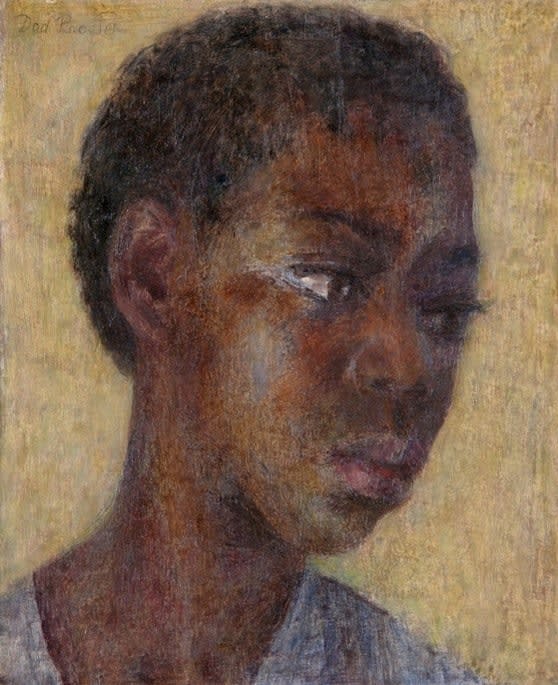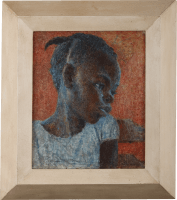Dod Procter was one of the most prominent British figurative artists of the mid-twentieth century and was celebrated for her sensitive portrayals of young women. This pensive study of a girl, named in the title as Davida, was almost certainly painted on one of the artist’s trips to Jamaica in the mid-1950s.
Procter’s prolific career spanned much of the twentieth century, but her work in the 1950s signifies a significant period of artistic exploration and innovation. While her earlier works were more academic in their approach to precise detail, her portraits from the 1950s demonstrate a shift towards a loose, impressionistic style. This encouraged a greater tonal range and a more realistic rendering of light and shadow which she skilfully exploited in her portraits of Jamaican sitters. Procter often criticised other artists, such as Augustus John, for their failure to convey the nuances of black sitters’ skin tones, despairing that he painted all black skin in the same...
Dod Procter was one of the most prominent British figurative artists of the mid-twentieth century and was celebrated for her sensitive portrayals of young women. This pensive study of a girl, named in the title as Davida, was almost certainly painted on one of the artist’s trips to Jamaica in the mid-1950s.
Procter’s prolific career spanned much of the twentieth century, but her work in the 1950s signifies a significant period of artistic exploration and innovation. While her earlier works were more academic in their approach to precise detail, her portraits from the 1950s demonstrate a shift towards a loose, impressionistic style. This encouraged a greater tonal range and a more realistic rendering of light and shadow which she skilfully exploited in her portraits of Jamaican sitters. Procter often criticised other artists, such as Augustus John, for their failure to convey the nuances of black sitters’ skin tones, despairing that he painted all black skin in the same colour.[1] Her own interpretation of flesh tones is observed in this work, through the nuanced hues of dark blue and green. Procter’s genuine concern to depict black subjects in such a considered way was rare amongst British artists at this date.
Procter’s extensive travels abroad were prompted by the unexpected death of her husband Ernest in 1935, which left her devastated and in need of change. The following year, she visited America and Canada, and by the 1950s her practice was governed by her extensive travels, which took her further afield to the Canary Islands, Tenerife and Jamaica. She returned to the Caribbean islands repeatedly, visiting Jamaica in 1953-4, 56, 58 and 61. Although we cannot know for certain, this portrait was likely painted during her first trip to Jamaica.
The composition and luminous quality of the paint share similarities with other works produced around this period [fig. 1 & 2]. As evidenced here, Procter developed a highly radiant quality in her works, often using soft pastel shades and subtle colour palettes which appear bathed in a diffused light, creating a dreamlike quality.[2]
[1] N. Welch, quoted in A. James, A Singular Vision: Dod Procter 1880-1982, Bristol: Sansom & Company Ltd, 2007, p.118.
[2] Also reflected in her submissions to the Royal Academy of Arts Summer Exhibition.















